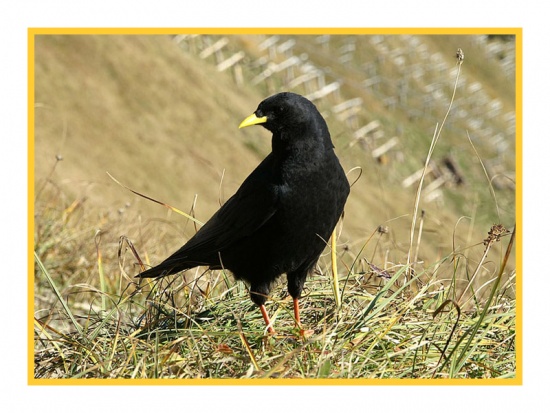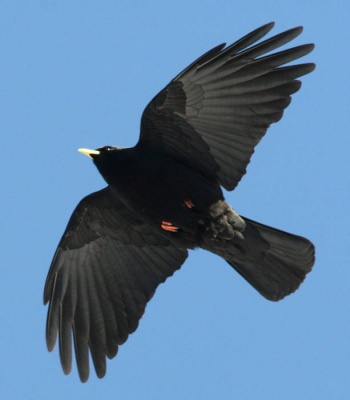(taxon, refs) |
|||
| (11 intermediate revisions by 6 users not shown) | |||
| Line 1: | Line 1: | ||
| − | + | [[Image:Yellow-billed_Chough.jpg|thumb|550px|right|Photo by {{user|Ken+Billington|Ken Billington}}<br />Staubern, [[Switzerland]]]] | |
| − | + | '''Alternative name: Alpine Chough''' | |
| − | [[Image:Yellow-billed_Chough.jpg|thumb|550px|right|Photo by Ken Billington<br /> | + | ;[[: Category:Pyrrhocorax|Pyrrhocorax]] graculus |
| − | |||
| − | |||
| − | |||
==Identification== | ==Identification== | ||
| + | 34-38cm (13½-15 in). A medium-sized corvid. | ||
| + | * Black plumage, weakly glossed bluish-green | ||
| + | * Fairly long tail, broad wings with fingered primaries, pinched wing-base with shorter inner primaries | ||
| + | * Short, yellow bill, slightly decurved | ||
| + | * Red legs | ||
| + | [[Image:13265KD0158 PKavka.jpg|thumb|350px|right|Photo by {{user|mikemik|mikemik}}<br />Krvavec, [[Slovenia]], February 2007]] | ||
| + | Sexes similar, juveniles with dull sooty black plumage, horn-coloured bill and black or dark brown legs (becoming red in the first winter). | ||
| + | ====Similar species==== | ||
| + | Can be confused with [[Red-billed Chough]] when bill is not seen. Differs with longer tail, narrower wings and less strongly fingered primaries. | ||
| + | ==Distribution== | ||
| + | Widespread and locally common in mountain areas of southern [[Europe]], North-West [[Africa]] and South-West [[Asia]]. | ||
| + | In Europe breeds in the Cantabrians, Sierra de Gredos and Pyrenees, in the Alps, [[Corsica]] and southern [[Italy]], and in the mountain ranges of southeast Europe to southern [[Greece]] and [[Crete]]. Recently recorded in southern [[Spain]] where thought to be recent immigrants from [[Morocco]]. | ||
| − | + | In North Africa breeds in the Rif and Atlas of central [[Morocco]] and in Asia in the mountains of eastern [[Turkey]] and the [[Caucasus]], and also occurs in the [[Middle East]] although current status unclear. Range extends eastwards across Central [[Asia]] to the [[Himalayas]]. | |
| − | |||
| − | |||
| − | + | Vagrants recorded in [[Czechoslovakia]], [[Hungary]], [[Gibraltar]], [[Cyprus]], and [[Armenia]]. | |
| − | Subspecies | + | The species is mostly resident with some altitudinal movement in winter. |
| + | ==Taxonomy== | ||
| + | [[Red-billed Chough]] is a close relative but [[White-winged Chough]] is not closely related. | ||
| + | ====Subspecies==== | ||
| + | There are 3 subspecies<sup>[[#References|[1]]]</sup>:<br /> | ||
| + | *''P. g. graculus'': | ||
| + | :*Mountains of [[Europe]], North [[Africa]], Caucasus and southern Caspian area | ||
| + | *''P. g. digitatus'': | ||
| + | :*Southern and southeastern [[Turkey]], south to the corner of [[Lebanon]], [[Israel]] and [[Syria]], east across northern [[Iraq]] to southwestern [[Iran]] (Zagros Mountains) | ||
| + | *''P. g. forsythi'': | ||
| + | :*Central [[Asia]] from central and northern [[Afghanistan]] northeast through the Pamirs and patchily on through the Tien Shan and Altai to Sayan Mountains and, in south, from west central and northern [[Pakistan]] (including an isolated population in northern Baluchistan) east in Himalayas to [[Nepal]], [[Bhutan]], and extreme western Arunachal Pradesh ([[India]]), and central and southwestern [[China]] | ||
| + | ==Habitat== | ||
| + | Mountain pastures and meadows with neighbouring cliff faces and rocky outcrops, also around high-altitude human habitation such as ski resorts. | ||
| + | ==Behaviour== | ||
| + | ====Diet==== | ||
| + | Their diet includes ground insects and their larva, including grasshoppers and beetles.They may also visit gardens for fruit and will scavenge at waste tips. | ||
| + | ====Breeding==== | ||
| + | Breeding season in Europe from May to June. Two birds form a life-long pair. Solitary nester but may form loose colonies. The nest is a bulky structure of sticks, roots and similar material, placed in a cliff, rock crevice, a cave or a rock chimney. Lays 4 eggs. | ||
| + | ====Vocalisation==== | ||
| + | Has distinctive calls. A sweet rippling "preeep" is most heard. | ||
| + | ==References== | ||
| + | #{{Ref-Clements6thAug21}}#{{Ref-HBWVol14}}#Avibase | ||
| + | #ArKive | ||
| + | {{ref}} | ||
==External Links== | ==External Links== | ||
| + | Search the Gallery using the scientific name: | ||
{{GSearch|Pyrrhocorax+graculus}} | {{GSearch|Pyrrhocorax+graculus}} | ||
| − | [[Category:Birds]] | + | <br /> |
| + | Search the Gallery using Yellow-billed Chouch: | ||
| + | {{GSearch|"Yellow-billed Chough"}} | ||
| + | Search the Gallery using Alpine Chough: | ||
| + | {{GSearch|"Alpine Chough"}} | ||
| + | {{GS-checked}} | ||
| + | <br /> | ||
| + | <br /> | ||
| + | [[Category:Birds]][[Category:Pyrrhocorax]] | ||
Latest revision as of 00:12, 21 July 2022
Alternative name: Alpine Chough
- Pyrrhocorax graculus
Identification
34-38cm (13½-15 in). A medium-sized corvid.
- Black plumage, weakly glossed bluish-green
- Fairly long tail, broad wings with fingered primaries, pinched wing-base with shorter inner primaries
- Short, yellow bill, slightly decurved
- Red legs
Sexes similar, juveniles with dull sooty black plumage, horn-coloured bill and black or dark brown legs (becoming red in the first winter).
Similar species
Can be confused with Red-billed Chough when bill is not seen. Differs with longer tail, narrower wings and less strongly fingered primaries.
Distribution
Widespread and locally common in mountain areas of southern Europe, North-West Africa and South-West Asia.
In Europe breeds in the Cantabrians, Sierra de Gredos and Pyrenees, in the Alps, Corsica and southern Italy, and in the mountain ranges of southeast Europe to southern Greece and Crete. Recently recorded in southern Spain where thought to be recent immigrants from Morocco.
In North Africa breeds in the Rif and Atlas of central Morocco and in Asia in the mountains of eastern Turkey and the Caucasus, and also occurs in the Middle East although current status unclear. Range extends eastwards across Central Asia to the Himalayas.
Vagrants recorded in Czechoslovakia, Hungary, Gibraltar, Cyprus, and Armenia.
The species is mostly resident with some altitudinal movement in winter.
Taxonomy
Red-billed Chough is a close relative but White-winged Chough is not closely related.
Subspecies
There are 3 subspecies[1]:
- P. g. graculus:
- P. g. digitatus:
- P. g. forsythi:
- Central Asia from central and northern Afghanistan northeast through the Pamirs and patchily on through the Tien Shan and Altai to Sayan Mountains and, in south, from west central and northern Pakistan (including an isolated population in northern Baluchistan) east in Himalayas to Nepal, Bhutan, and extreme western Arunachal Pradesh (India), and central and southwestern China
Habitat
Mountain pastures and meadows with neighbouring cliff faces and rocky outcrops, also around high-altitude human habitation such as ski resorts.
Behaviour
Diet
Their diet includes ground insects and their larva, including grasshoppers and beetles.They may also visit gardens for fruit and will scavenge at waste tips.
Breeding
Breeding season in Europe from May to June. Two birds form a life-long pair. Solitary nester but may form loose colonies. The nest is a bulky structure of sticks, roots and similar material, placed in a cliff, rock crevice, a cave or a rock chimney. Lays 4 eggs.
Vocalisation
Has distinctive calls. A sweet rippling "preeep" is most heard.
References
- Clements, J. F., T. S. Schulenberg, M. J. Iliff, S. M. Billerman, T. A. Fredericks, J. A. Gerbracht, D. Lepage, B. L. Sullivan, and C. L. Wood. 2021. The eBird/Clements checklist of Birds of the World: v2021. Downloaded from https://www.birds.cornell.edu/clementschecklist/download/
- Del Hoyo, J, A Elliott, and D Christie, eds. 2009. Handbook of the Birds of the World. Volume 14: Bush-shrikes to Old World Sparrows. Barcelona: Lynx Edicions. ISBN 978-8496553507
- Avibase
- ArKive
Recommended Citation
- BirdForum Opus contributors. (2024) Yellow-billed Chough. In: BirdForum, the forum for wild birds and birding. Retrieved 7 May 2024 from https://www.birdforum.net/opus/Yellow-billed_Chough
External Links
Search the Gallery using the scientific name:
Search the Gallery using Yellow-billed Chouch:
Search the Gallery using Alpine Chough:
GSearch checked for 2020 platform.





